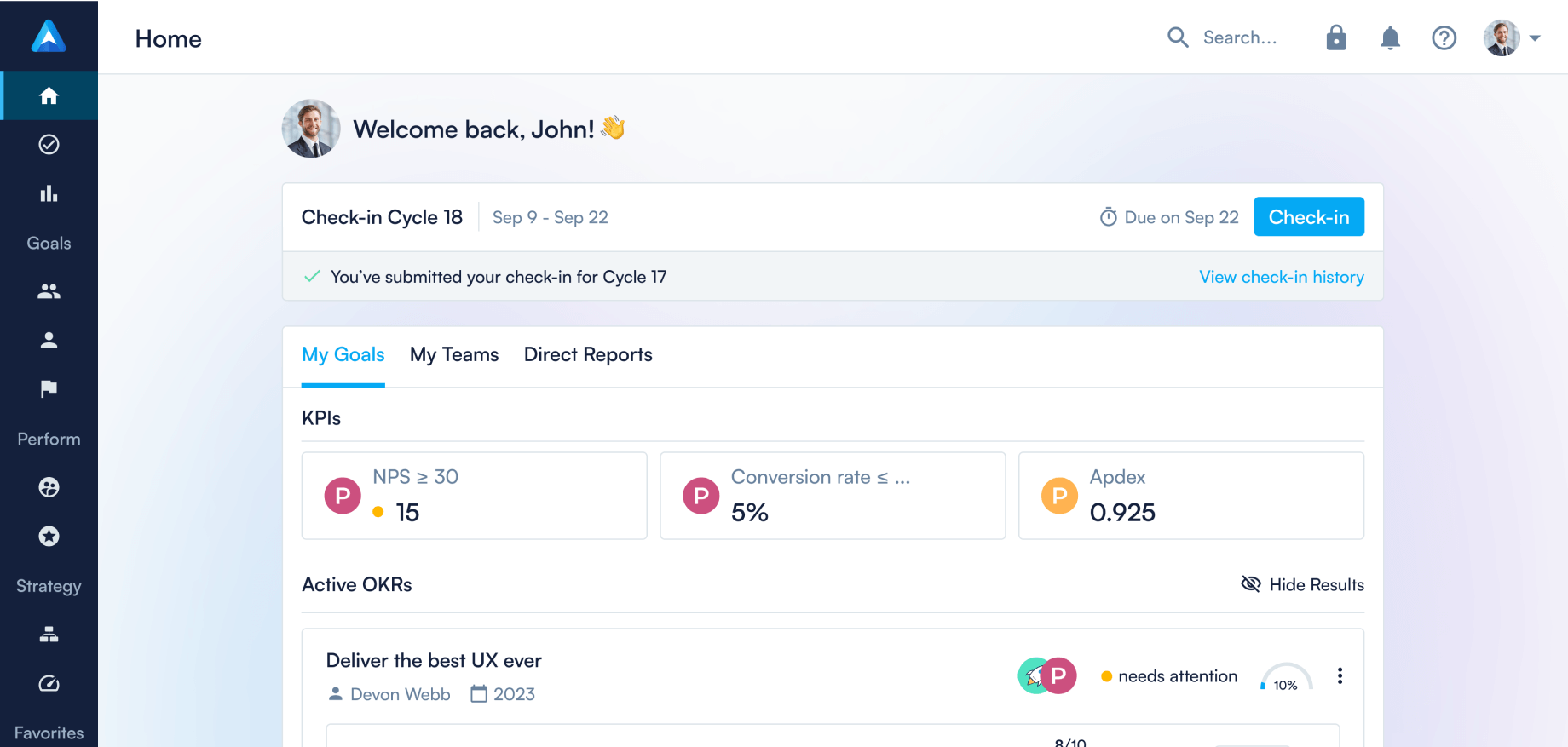
7 requirements for a successful OKR implementation

Rather watch a video? Scroll down!
You've probably read Measure What Matters, maybe watched a TED talk, that famous Google OKR video, or even our OKR crash course. You’ve got the basics of OKR covered. It’s time to put that knowledge into action.
Implementing OKR may be daunting at first, but it’s actually where the magic begins. At Perdoo, we’ve helped thousands of organizations successfully implement OKR. We’ve seen what works, and what doesn’t. In this article, we’ll share the 7 requirements for a successful organization-wide OKR implementation. So, let’s get into it!

Ensure senior leadership backing
Let’s face it, senior leadership acts as a role model for the rest of the organization. And since OKR requires a shift in how everyone in an organization approaches work, if senior leadership lacks consistency and commitment to that change, the rest of the organization will likely not follow. That means OKR will fail. So, in order to roll out OKR across your entire organization, backing from senior leadership — the CEO especially — is an absolute must.
To get senior leadership on board, it’s critical to convey the value OKR brings to an organization. If senior leadership is on board to begin with, nice work! You can skip this step.
Some initial steps:
- Provide an introductory OKR presentation, clearly outlining the benefits and business impact for your organization
- Present case studies to give leadership an idea on timing, budget, and impact
Once they’ve expressed a clear commitment to the framework, the next step is to ensure they’re actually walking the walk:
- Put OKRs on the agenda for All-Hands and leadership meetings
- Regularly approve company and quarterly team OKRs
- Speak the OKR language, e.g. the difference between a Key Result and a KPI
Get buy-in from the rest of the organization
While getting senior leadership buy-in is critical, your people are the ones driving execution. Some people will embrace OKR with open arms, and you may face resistance from others. They either don’t see the benefit of using such a framework or see it as just one more thing to do, and that’s a fair concern. But at this point, it’s important to highlight what’s in it for them and the organization as a whole.
If you’re working with the Perdoo software, your people have full access to the organization’s strategy and the goals (OKRs and KPIs) that’ll deliver it. They’ll now have complete transparency on the priorities of each area of the business and have clarity on what’s expected of them and how they can have the biggest impact.
Here are few additional steps to strengthen that buy-in:
- Schedule an All-Hands meeting to kick off the OKR implementation and outline the benefits of the framework
- Share success stories of other organizations
Define your rollout approach
How you decide to roll out OKR across your organization depends a lot on your organization’s characteristics, culture, and prior experience with OKR. But before you start it’s good to have a rough understanding of how you’ll approach it. In our experience, there are two approaches that we see have the most success:
An organization-wide rollout, from the very beginning: This works best if your organization is already familiar with the OKR framework. This could also work if you have a culture open to change. Younger companies, regardless of their size, qualify more easily for such an approach than more mature companies, due to the likelihood of more flexible structures and processes.
Do note that, if you’re using a dedicated software, like Perdoo, we’re still not suggesting that everyone should have access to the software immediately. It’s best to first set up the accounts and OKRs of senior leadership, then roll it out to all the departmental heads and team leaders, and from there to the rest of your organization. It does mean that all of this is done in a very short time span (eg <30 days), ensuring not to lose momentum.
A step-by-step rollout: With this approach, you typically begin with a “pilot group” — for example, the senior leadership, a specific team, or department. That way this group has the opportunity to fully get the hang of OKR, and collect necessary learnings to establish the best approach for the rest of the organization.
Once this group is up and running (e.g. after one quarter’s OKRs) it’ll be clear what the next steps are for the rest of the organization. You could then either roll it out to the rest of the organization or roll it out to a few groups gradually. If you feel uncertain or are expecting resistance, the latter is likely the best option — other groups and individuals lead by example increasing the likelihood of others buying in.
Always remember: there’s no right or wrong way of rolling out OKR. It depends on what fits your organization best.
Appoint an Ambassador
We can’t say this enough: by implementing OKR, you’re driving positive change within your organization. And, whether you’re new to OKR or are seasoned users, we recommend nominating an Ambassador to spearhead that change. The Ambassador takes on the role of an internal OKR expert, with responsibilities that revolve around mentorship and management.
OKR isn’t a “set and forget” type of framework, instead, it needs to stay front and center at all times to be able to yield success for your organization. Plus, in the beginning, it will take time to get right, so having a dedicated person overlooking that process can make a world of difference.
Here’s what an Ambassador does:
- Leads the OKR implementation
- Trains and mentors people on the OKR framework
- Creates processes and ensures they’re being followed
- Sets up and administrates your OKR tool
- Assists teams in creating and closing OKRs
Define your program’s rhythm
A well-designed OKR program provides clarity on what’s expected and when you expect it to happen. That means defining cadences and timeframes, as well as check-in and progress review frequency.
Just getting started with designing your OKR program? Here’s a template for you to create the perfect OKR program for your organization. Once it’s ready, share it with your organization to ensure they know what’s expected of them and when.
Now, let’s talk about defining cadences, timeframes, check-in, and progress review frequency.
Cadences and timeframes: The word cadence can sound a bit fancy, but it simply communicates how often you’ll be creating goals both at the company and team level. The standard configuration is annual company-level OKRs and quarterly team OKRs, but this of course can be adapted to your organization’s needs.
The idea is to work with a combination of cadences that interact with each other to create a rhythm of continuous and focused progress. So make sure to choose 2 cadences: high-level goals with a longer horizon that can only be achieved by working toward smaller goals with a shorter horizon. Hint: if you’re using Perdoo, you have complete flexibility around the length and number of cadences you use.
Check-in & progress review frequency: Staying on top of OKR progress is the key to success. We found that organizations updating and reviewing their goals’ progress frequently are more likely to achieve their goals. Therefore, to ensure execution succeeds, it’s important to clearly define a frequency at which people need to update progress on their goals.
This cadence will need to be reinforced by the Ambassador, leadership, and managers, especially at the beginning, and until it becomes second nature.
Our recommendation: Check-in on quarterly OKR progress on a weekly basis, or no longer than every two weeks.
Educate everyone on the OKR framework
OKR is a new language, and to avoid any confusion and ensure everyone is speaking the same language, the entire organization should receive training on the framework.
Such training can be delivered through online training, as it’s more scalable and cost-effective, but some organizations also opt for workshops. We’ve seen both methods work really well, and the good news is that Perdoo offers both free and paid resources to support your needs. We’ve shared some resources below.
Free resources that can help:
- The ultimate guide to OKR: everything you need to know about getting started with OKR.
- How to write great OKRs: an all-in-one guide on how to create OKRs that matter.
- The OKR examples guide: a library of example OKRs to provide inspiration when setting OKRs.
Free resources for leadership:
- Looking to get aligned? Put strategy first, OKR second: a guide on what makes a great strategy, and how to set one for your organization.
- The growth handbook for CEOs: a complete guide for leadership on what it takes to help your organization grow.
- The ultimate guide to KPIs: everything you need to know about getting started with KPIs.
Paid resources:
- Online OKR training: an online introduction to OKR
- Coaching packages: tailored training conducted by our OKR experts to help your organization and teams succeed
Train the OKR ‘muscle’
Once your teams and people are up to speed with the OKR framework, it’s essential to put that knowledge into practice. Writing great OKRs can be challenging, especially if no one in the organization has defined OKRs, or goals for their work before. Look at it as a muscle: train it and you’ll quickly get better.
To increase this learning curve it’s advisable to let teams and departments sit together to review their OKRs and give feedback to each other. And, to further embed OKR within your organization’s culture, leadership and teams should discuss OKR outcomes in team and All-Hands meetings, and managers should discuss their people’s OKR-related behaviors in 1:1s.
Conclusion
To conclude, keep it simple. These requirements above may feel like a lot to take in at one go, but we can guarantee that the OKR framework is simple, flexible, and forgiving. It comes with a set of best practices to ensure its success, but once you get the hang of it and you make it your own, it’ll become second nature and will only get better.
If anything, remember this: get that buy-in, assign an Ambassador, plan your process and program, introduce and educate, and put OKR into practice. Good luck!
Watch video
FAQ
Continue reading...


Why you shouldn’t outsource OKR to HR


How to embed goals in performance reviews







